Sandwich in Spanish: How to Say “Sandwich” in 21 Ways!
Disclaimer: Links on this page may be affiliate links. If you make a purchase after clicking a link, I may receive a small compensation to help power my site at no cost to you.
How do you say, “sandwich” in Spanish? Learn how to say sandwich in Spanish—no matter which country you visit!
If you’re preparing to travel to a Spanish-speaking country such as Spain, you’re going to want to learn how to say “sandwich” in Spanish.
Why? Because at some point you’ll want to eat a sandwich!
While the most common word used to describe a sandwich in Spanish is “sándwich,” there are actually a variety of words that can be used to refer to this popular food item (We’ve included over 20 of them on this list, alone).
How do I know? I’m a former Spanish teacher! Studying the Spanish language is one of my passions, so much so that I moved to Spain for a while before getting a Master’s degree in Foreign Language Education!
All this to say, “sandwich” in Spanish should be among the words to learn on your Spanish journey. In this post, we’ll go over 21 different ways to say “sandwich” in Spanish to help you confidently order in your second language.
How to Say Sandwich in Spanish (21 Ways)
When it comes to how to say or how to spell sandwich in Spanish, it depends on which types of traditional Spanish sandwiches you are referring to.
See 21 different ways to say “sandwich” in Spanish, along with a brief description of each type:
1. Sándwich
🗣 sahnd-gweech
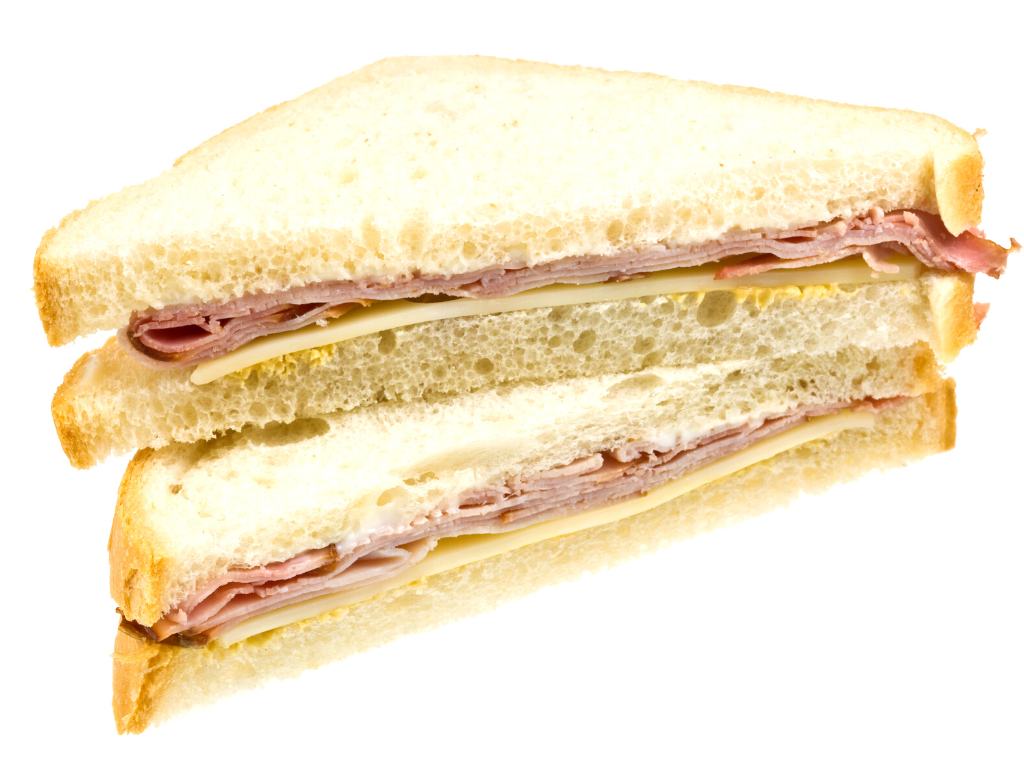
The most accepted way to say sandwich in Spanish is “sándwich.” This is a direct translation of the English word “sandwich.”
The true definition of a sándwich (according to the RAE, the governing body over the Spanish language) a sandwich is “made with two slices of sliced bread (pan de molde) between which ham, cheese, sausage, vegetables or other foods are placed.”
—Los sándwiches son ideales para un almuerzo rápido y delicioso.
—Sandwiches are perfect for a quick and delicious lunch.
However, sándwich has become a rather universal term used to refer to sandwiches in Spanish-speaking countries. You’ll likely be understood if you use the word sándwich in Spanish, but you might not end up with the type of sandwich you want!
(Thus, keep reading for the specific ways to say in Spanish “sandwich” in different countries…)
As for how to pronounce sandwich in Spanish, say, “sahnd-gweech.” No, there’s no “g” in the Spanish spelling, but the w in front of a vowel makes it sound as so.
In fact, many native Spanish speakers in the US pronounce and/or spell sandwich as “sanguich” because of this! Just look at the multitude of “sanguich” shops in Miami, for instance!
2. Bocadillo
🗣 boh-cah-dee-oh

In Spain, “el bocadillo” is the most frequently used term for a sandwich in Spanish.
A bocadillo is a type of sandwich that is made on a Spanish-style baguette (pan de barra). This famous Spanish food is simple, often filled with just a few ingredients. Popular fillings are Serrano ham, Manchego cheese, or Spanish omelet (tortilla española) drizzled with olive oil or a little mayonnaise.
Want to order half a bocadillo? Just ask for a “montado.”
— Cuando viajo en tren, siempre llevo un bocadillo para comer durante el viaje.
— When I travel by train, I always bring a sandwich to eat during the journey.
3. Sánduche
🗣 sahnd-ooh-chay

Sánduche is a variation of the word “sandwich” that’s used in countries like Colombia, Ecuador, and Venezuela.
Often made on sub-type sandwich rolls or round buns, sánduches are filled with meat, cheese, and vegetables.
A famous Ecuadorian sandwich is the “sánduche de chancho hornado.” This roast pork sandwich if topped with has lettuce, pickled red onions, tomato slices, and avocado. “¡Yummi!”
—Me encanta pedir un sánduche de jamón y queso en mi cafetería favorite.
—I love ordering a ham and cheese sandwich at my favorite café.
By the way, sandwiches follow the same rules for pluralization as other nouns. Thus, the plural for el sánduche is los sánduches.
3. Sánguche
🗣 sahnd-goo-chay
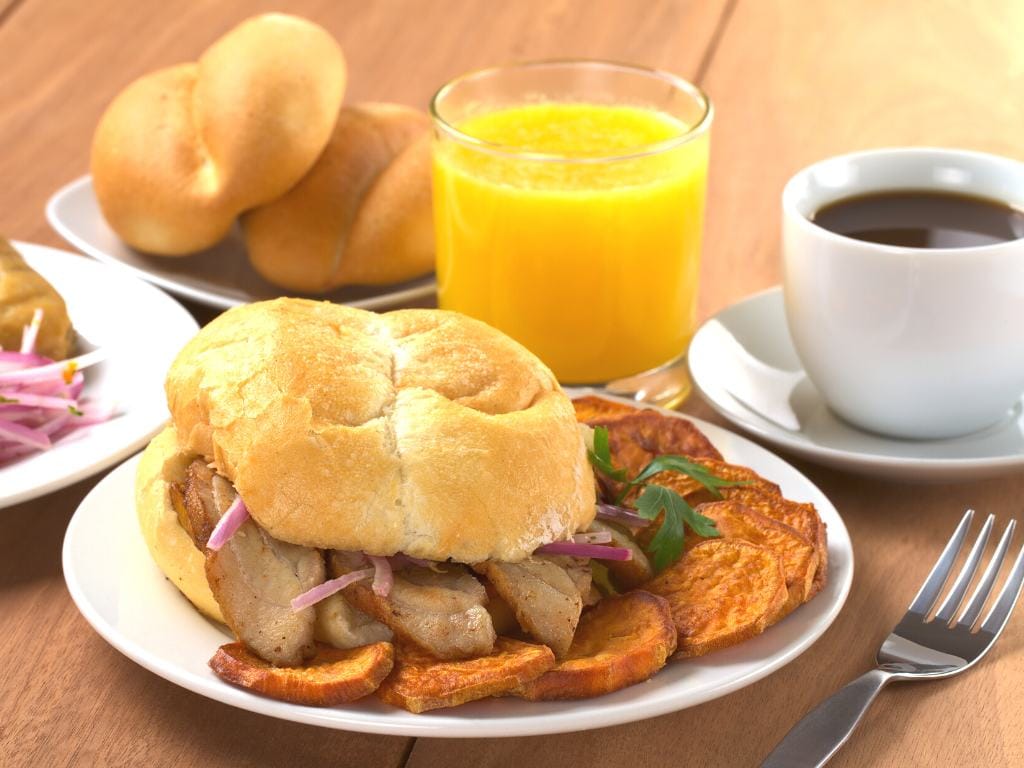
Sánguche is a word for sandwich in Spanish routinely used in the Andes (Peru, Argentina, and Chile) as well as Paraguay and Uruguay.
In Peru, you can pick up a sánguche from a Sanguchería, a restaurant specializing in sandwiches. Oh, and sánguches go good for breakfast, lunch or dinner.
One particular Peruvian sandwich staple is a butifarra. Served on a crispy white bun, it’s filled with spicy ham infused with garlic, and topped with criolla sauce, lettuce, radishes, and chiles.
—El sánguche de pavo es una opción saludable para el almuerzo.
—Turkey sandwices are a healthy lunch option.
4. Sándwiche
🗣 sahnd-gwee-chay
Sándwiche is a spelling of the English word “sandwich” that is sometimes used in the Southern Cone, the region of South America consisting of Brazil, Paraguay, Uruguay, Argentina, and Chile.
Sándwiches can be filled with a variety of ingredients, such as meat or vegetables, and all sorts of yummy spreads and sandwich toppers.
—¿Me puedes traer un bocadillo de jamón, por favor?
—Can you bring me a ham sandwich, please?
By the way, words that are directly taken from English (or other languages) are called borrowed words or loanwords. Words that start with W in Spanish consist of tons of loanwords.
5. Emparedado
🗣 em-pah-reh-dah-doh
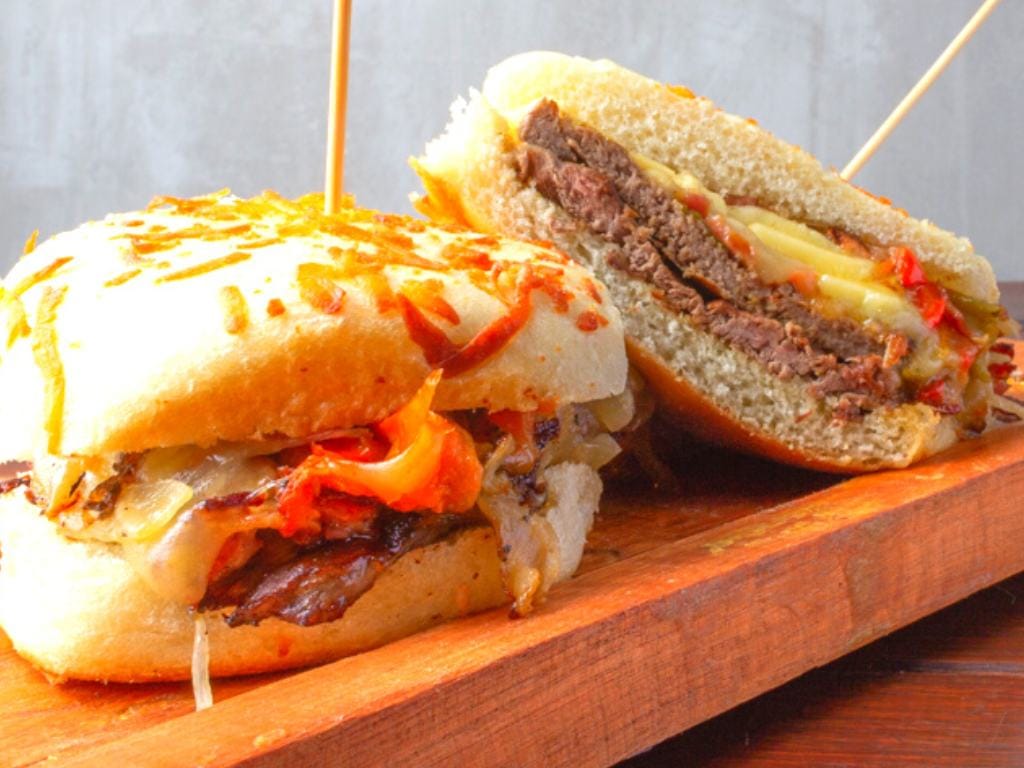
An everyday word used to describe a sandwich in Spanish is “emparedado.”
The Real Academia Española (RAE) puts it succinctly: an emparedado is a “small portion of ham or other food, between two slices of sliced bread.”
That being said, emparedados can refer to any type of sandwich, including ones made with bread, tortillas, or other types of flatbread. It’s important to note, however, that this Spanish sandwich word isn’t used everywhere, although it’s more frequently heard in Latin America and Cental America.
—Mi madre hace el mejor emparedado de pollo con aguacate.
—My mother makes the best chicken and avocado sandwich.
6. Bocata
🗣 bow-cah-tah
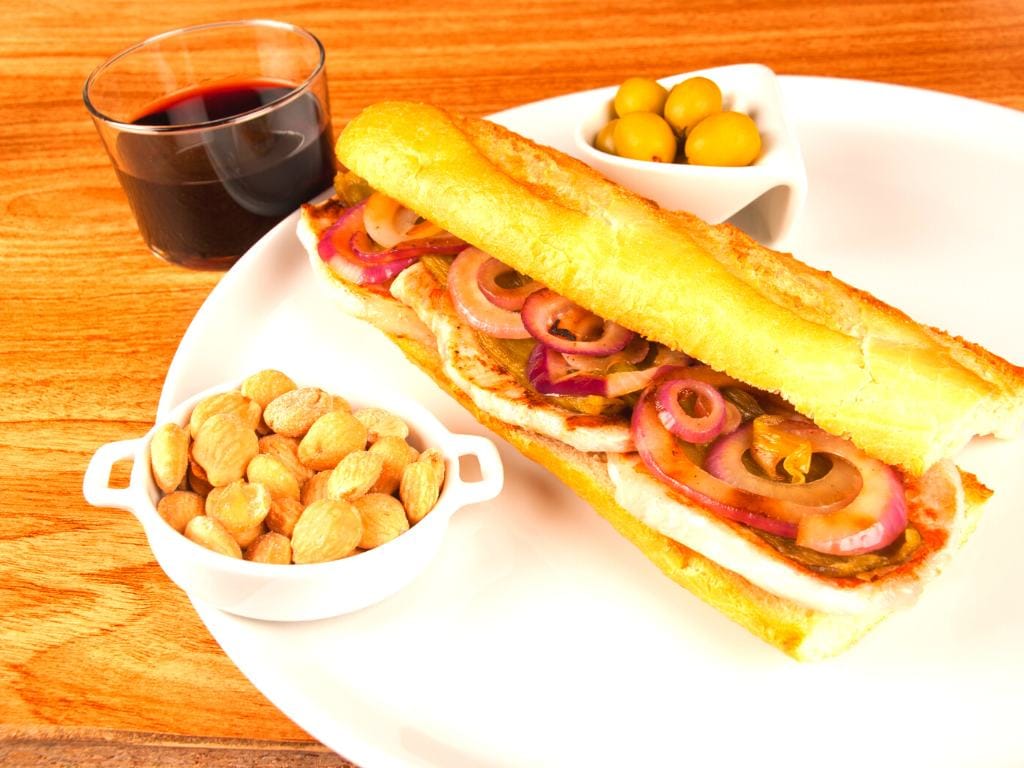
A bocata is a colloquial term for bocadillo, a type of sandwich that is famous in Spain. It is typically made with a Spanish-style baguette and is filled with simple ingredients such as ham, cheese, or tuna.
You can use the word bocadillo just about everywhere, but reserve bocata for situations where you know it’s appropriate (like when it says bocata on the menu!) since it’s slang.
— Por favor, ¿me puedes preparar un bocata de pollo para llevar?
— Could you please make me a chicken sandwich to go?
7. Torta
🗣 tohr-tah
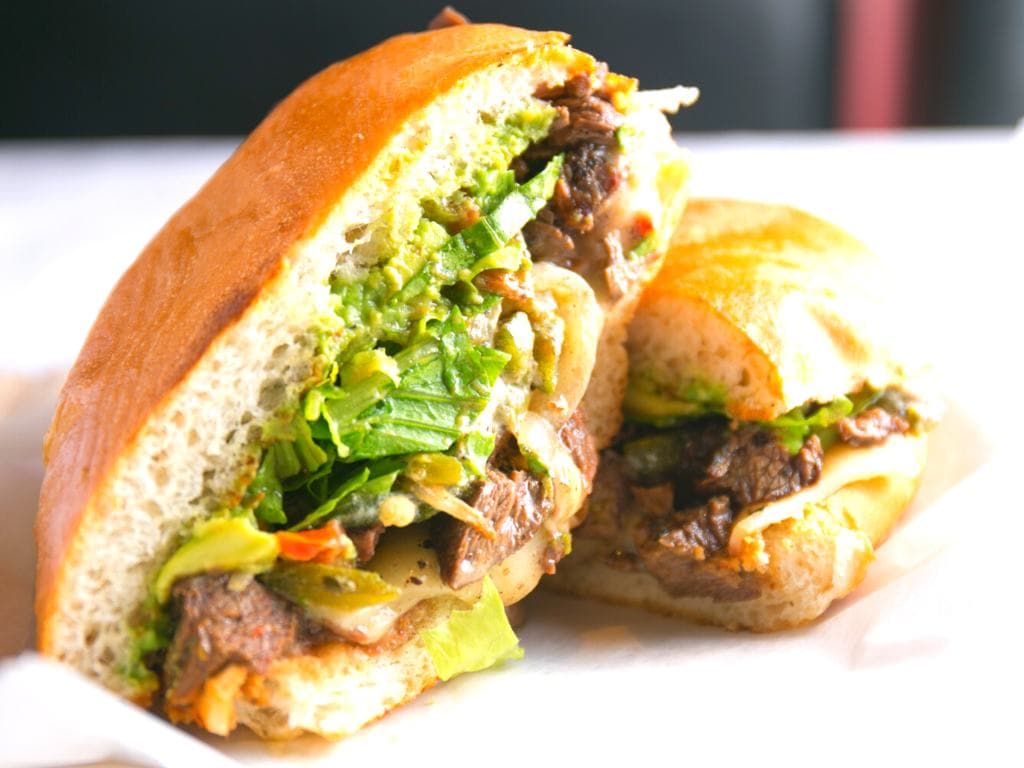
Search any Spanish dictionary, and you’ll find one the most famous ways to say sandwich in Spanish is torta.
A torta is a Mexican sandwich made with a type of bread called telera (or similar). Tortas can be filled with various sandwich ingredients: beans, cheese, pickled onions, avocado, meat, etc.
Tortas aren’t exclusive to Mexico. To illustrate, Guadalajara’s hangover staple is called the “torta ahogada” (drowned sandwich). The savory buns are stuffed with pork and dipped in a spicy sauce made from vinegar, cumin, and chile de árbol.
Remember, in Spanish, all adjectives must agree in number and gender with the nouns they modify. Therefore, if you want to describe a torta with an adjective, be sure to follow the rules! (Bolded in the example, below).
— En la panadería de la esquina hacen las mejores tortas de jamón y queso.
— The bakery on the corner makes the best ham and cheese sandwiches.
8. Mollete
🗣 moe-yeh-tay
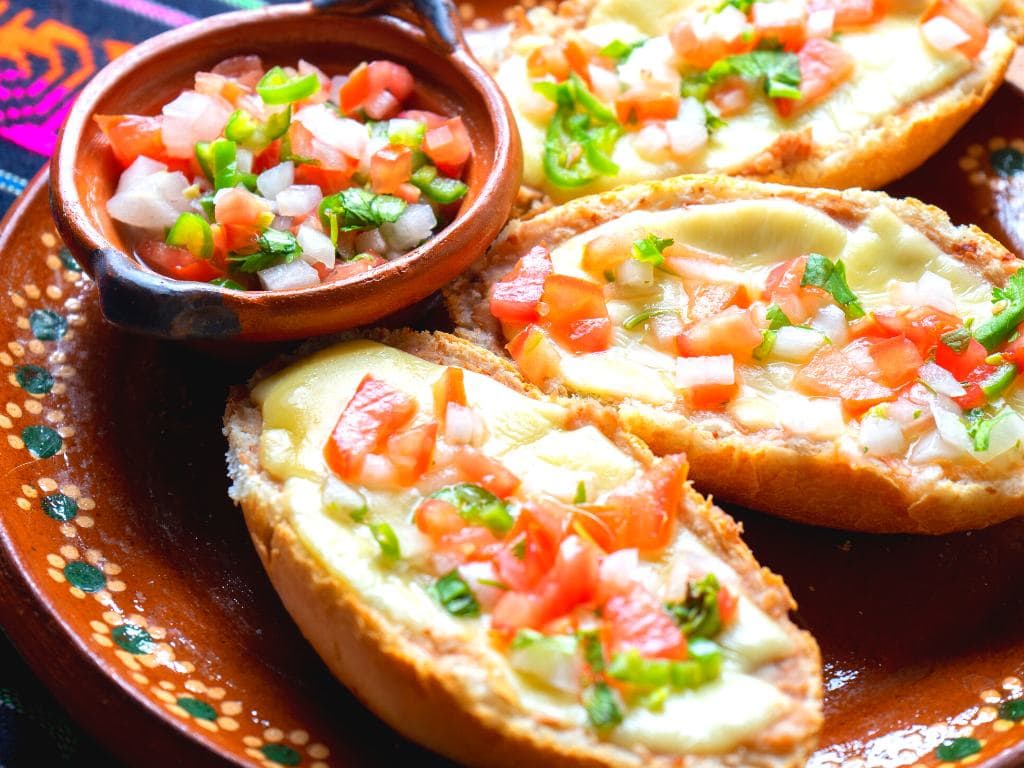
A mollete is a toasted open sandwich topped with refried beans, Mexican cheese, and salsa.
This type of sandwich is perfect for breakfast, lunch, or a tasty snack.
— Hoy en el desayuno quiero un mollete con jugo de naranja.
— For breakfast today, I’d like a toasted sandwich with orange juice.
9. Pambazo
🗣 pahm-bah-soh
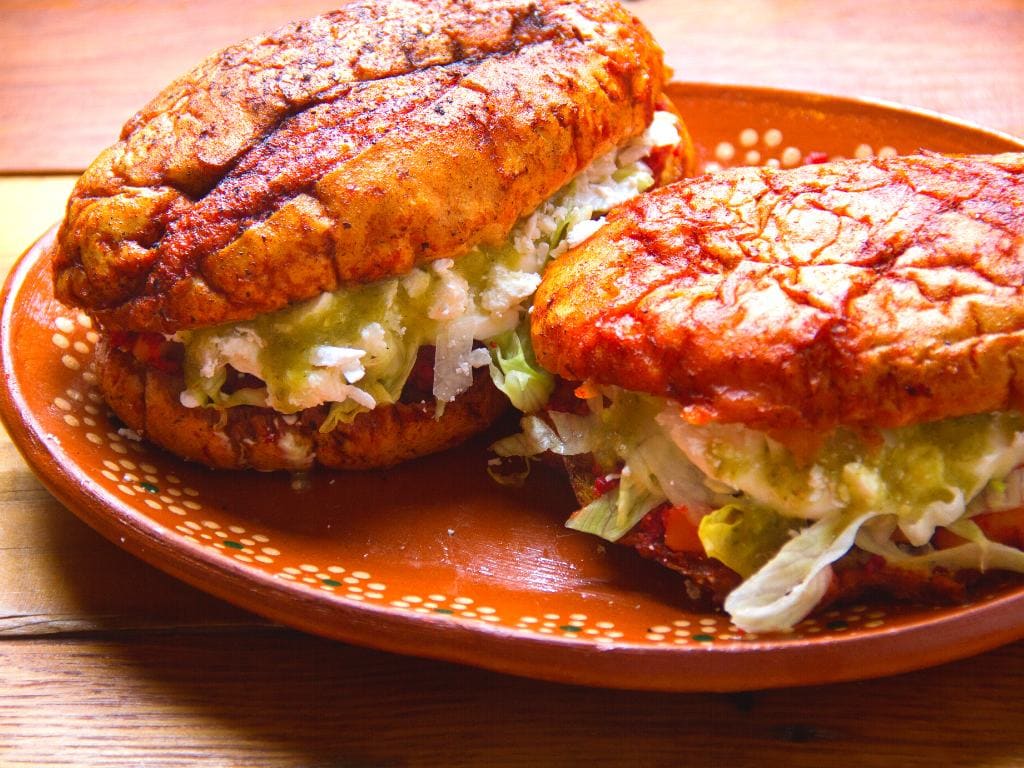
A lesser-known Spanish sandwich word is pambazo.
A famous street food in Mexico, a pambazo sandwich is inspired by a volcano! Dyed red with spicy guajillo sauce, take a bite to find potatoes and Mexican chorizo topped with lettuce, cheese, and cream.
— En la feria de comida callejera, siempre pido un pambazo de chorizo.
— At the street food fair, I always order a chorizo sandwich.
10. Montadito
🗣 mohn-tah-dee-toh
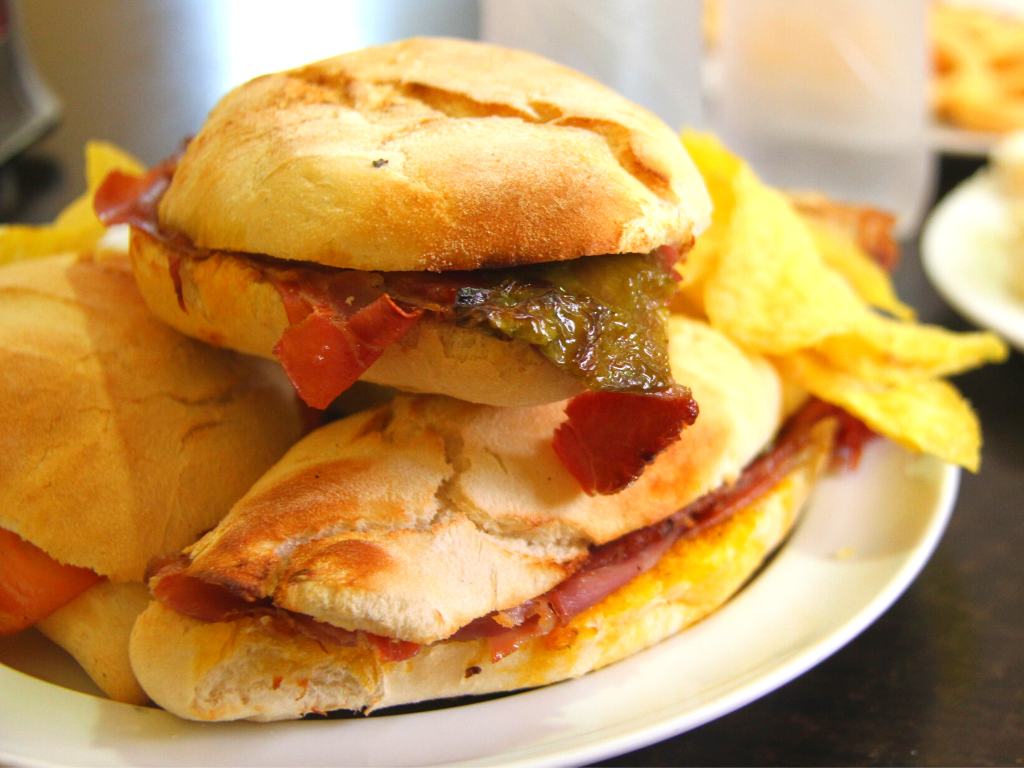
When learning how to say sandwich in Spanish, it’s essential to know what a montadito is before visiting Spain.
Montaditos are small sandwiches served on a small, baguette-like bread. They are often served as tapas (a small snack with a drink). In some regions, montaditos are served open-faced on a sandwich board.
Montaditos can be filled with a variety of yummy ingredients from ham, chicken, and sardines to tomato and cheese. To try a variety of this Spanish sandwich variety, head to 100 Montaditos, a chain found throughout Spain with snacks starting around 1€ each.
— Para la fiesta, vamos a servir una variedad de montaditos con diferentes toppings.
— For the party, we’re going to serve a variety of small sandwiches with different toppings.
11. Chivito
🗣 chee-bee-toh

A chivito is a type of Uruguayan sandwich. It’s ordinarily made with steak, ham, bacon, lettuce, mayonnaise, and melted mozzarella cheese.
Even better, chivitos are stacked on a round roll and topped with a fried egg. Now that’s what we call a sandwich!
— En el restaurante uruguayo, te recomiendo pedir un chivito.
— At the Uruguayan restaurant, I recommend ordering a Uruguayan sandwich.
12. Pepito
🗣 pehy-pee-toh
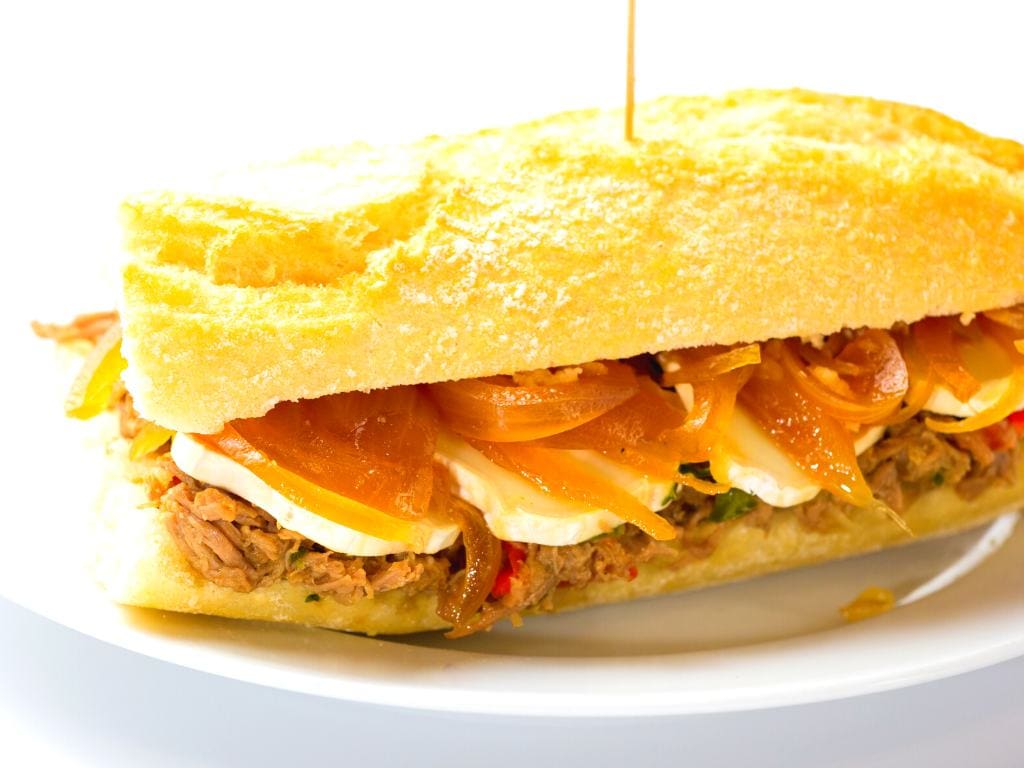
Pepitos are a beloved sandwich that originated in Spain but can be found in several other Spanish-speaking countries.
These sandwiches are usually filled with thinly sliced or grilled beef or pork. Some versions of the pepito sandwich include additional toppings like cheese, lettuce, tomatoes, and mayonnaise.
The Venezuelan pepito is a well-loved favorite filled with steak, tomatoes, cheese, lettuce, crispy potatoes, and mayo.
— ¿Me traes un pepito de carne con cebolla caramelizada, por favor?
— Could you bring me a beef pepito with caramelized onions, please?
13. Lonche
🗣 loahn-chay

A lonche is a submarine sandwich popular in Mexico, particularly Jalisco.
The sandwich is made with a type of bread called bolillo, which is hard on the outside and soft inside. Quality meats and cheese, lettuce, tomato, onions, guacamole, and pickled jalapenos all make great fillings for lonches!
— Cuando venga mi amiga, le voy a ofrecer un lonche de pavo y aguacate.
— When my friend arrives, I’ll offer her a turkey and avocado sandwich.
Lonche is also an Americanized word for lunch in the United States and refers to a light afternoon meal or snack in some countries in Latin America.
14. Pebete
🗣 pey-beh-tay
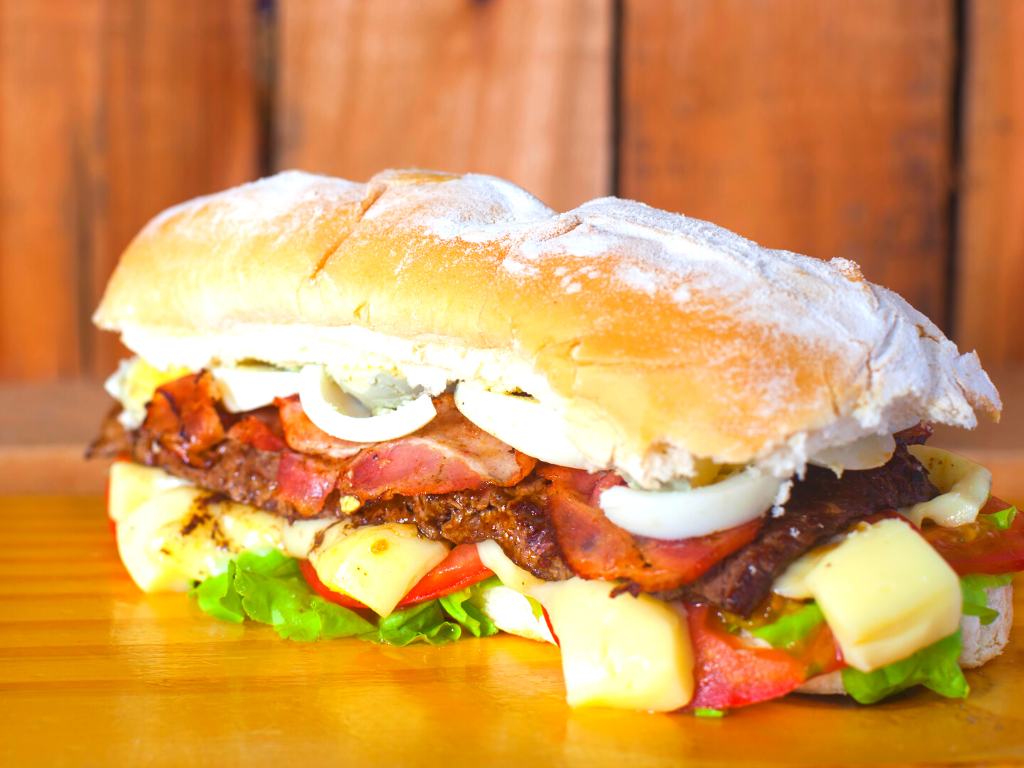
One way to say sandwich in español is pebete. Pebetes are typical in Argentine cuisine and are often associated with childhood in the former since pebete means little boy in Argentina.
They are made on soft oval buns, similar to an elongated hot dog bun. Classic fillings are cheese, cured meat, tomato, and mayonnaise.
To ask for a certain filling in your sandwich, use the word sandwich filled by “de” and the filling. For example, pebete de queso means cheese sandwich. This goes for other types of sandwiches in Spanish, too.
— En el picnic, vamos a tener pebetes de jamón y queso para todos.
— At the picnic, we’ll have ham and cheese sandwiches for everyone.
15. Chori / Choripán
🗣 cho-ree, cho-ree-pahn
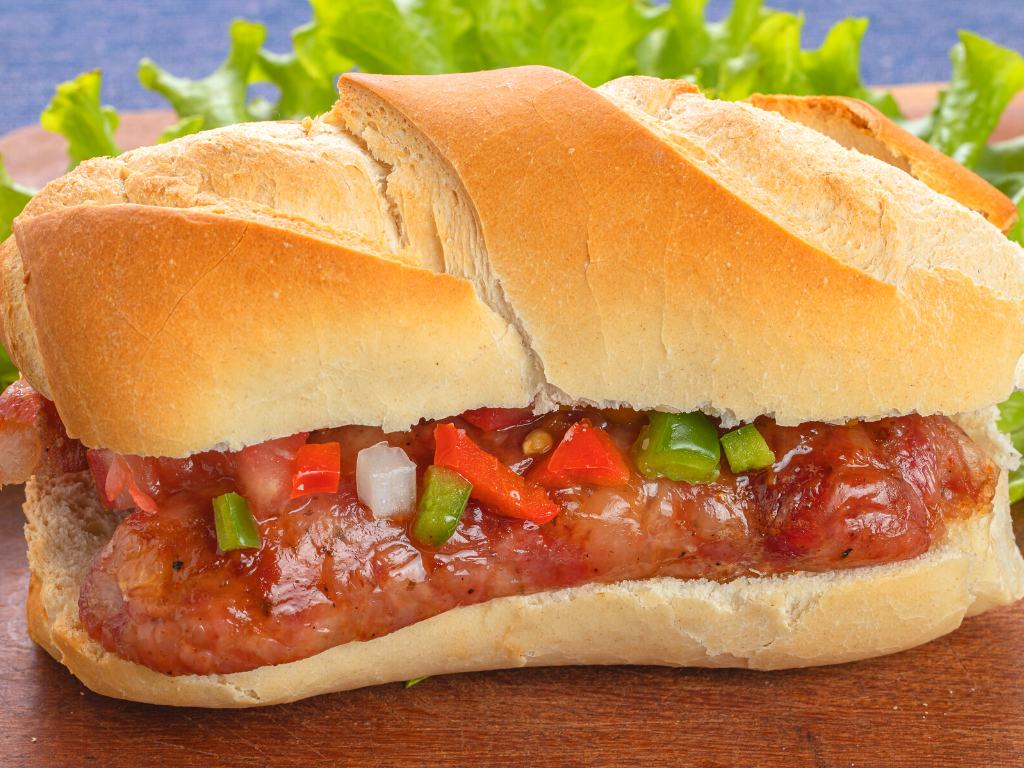
A chori or choripán is a type of sandwich in Argentina.
Chorizos with mustard and chimichurri make up the essentials of choripán.
Argentine gauchos (cowboys) make incredible grilled meats to accompany the chorizo, mustard, and chimichurri characteristic of a chori.
Choris are sold at food trucks, cafes, street vendors, and restaurants throughout the country.
— El choripán es el plato perfecto para disfrutar en un partido de fútbol.
— Choripán is the perfect dish to enjoy at a soccer game.
16. Bikini
🗣 bee-key-knee

One quintessential Spanish sandwich with a non-typical name is the bikini!
Spain’s bikini sandwich consists of two pieces of grilled white bread stuffed with ham and cheese. Some people compare it to France’s “croque-monsieur.” (Tastes just as good in francés!)
Despite it’s funny name, bikinis are delicious!
— En la cafetería, suelen servir un delicioso sándwich bikini.
— In the café, they often serve a delicious bikini sandwich.
By the way, do you want to know how to say delicious in Spanish? Find out how.
17. Pancho
🗣 pahn-cho

Panchos are Argentina’s take on hot dogs with a vast array of toppings. Top your juicy sausage with cheese, bacon, shredded cabbage, mayonnaise, ketchup, mustard, or chimichurri, to name a few.
But “pancho” isn’t just a type of sandwich in Spanish, it’s also a traditional, blanket-like garment, a man’s name, and slang term for someone who’s carefree or relaxed.
— En la parrillada, no pueden faltar los panchos con todos los condimentos.
— At the barbecue, you can’t miss the hot dogs with all the toppings.
18. Pulga / Pulguita
🗣 puhl-gah, puhl-gwee-tah
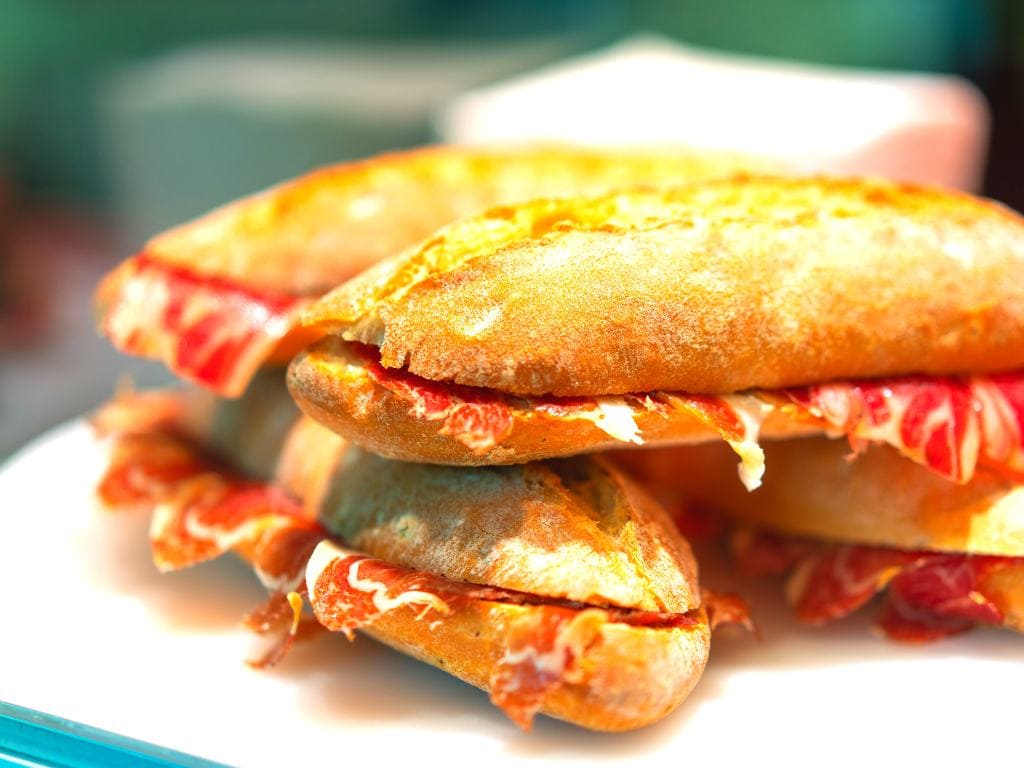
A pulga is a 4-inch(ish) sandwich found in Spain. Slightly larger than a montadito but smaller than a bocadillo, they’re usually served cold as a tapa in bars.
Here’s a fun fact for you: the word pulga in Spanish also means flea!
— En el estadio, venden pulgas de jamón y queso ideales para picar algo.
— At the stadium, they sell ham and cheese sliders, perfect for snacking.
19. Sándwich cubano
🗣 sahnd-gweech koo-bah-noh
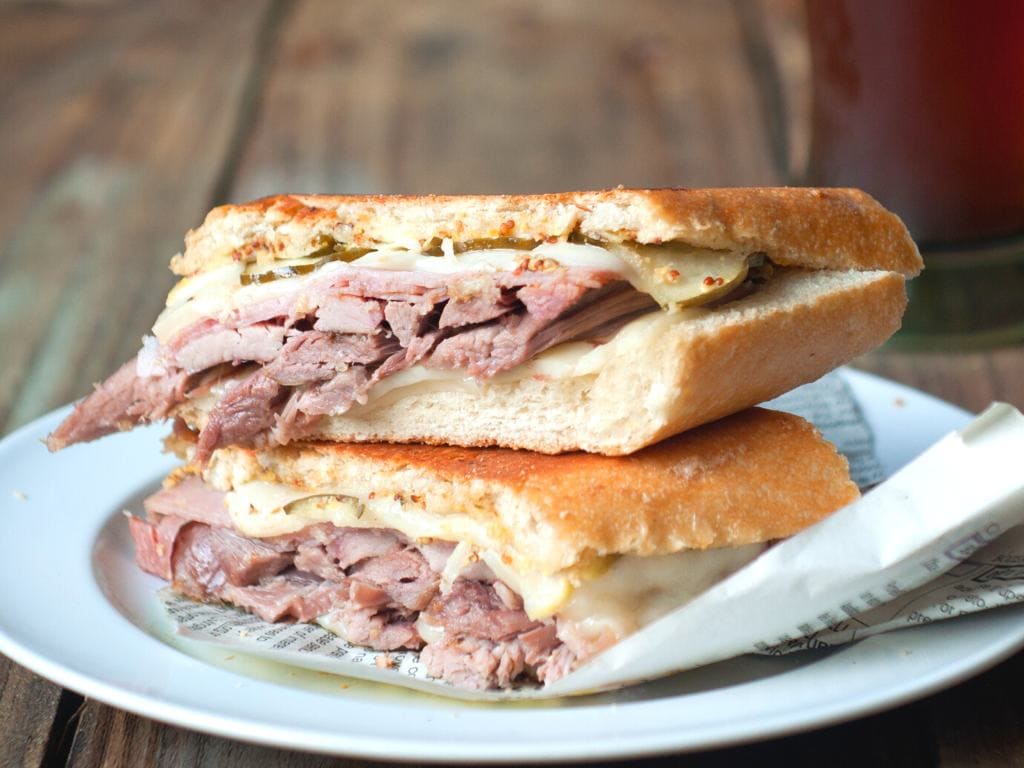
One of the most important sandwiches to learn the Spanish word for is the cubano. This succulent Cuban sandwich (or sangüich) is a favorite in Florida, Miami, and Tampa (although I had my first one in Seattle!)
Wherever you eat a sándwich cubano, you’ll find the most traditional ones topped with cooked ham, roast pork, pickles, mustard, Swiss cheese, and butter pressed between chunks of fluffy Cuban bread called medianoche (mightnight).
— Cuando visité Miami, probé un auténtico sándwich cubano en una cafetería local.
— When I visited Miami, I tried an authentic Cuban sandwich at a local café.
20. Cemita
🗣 seh-mee-tah

The cemita is a standard in Puebla, Mexico. It consists of a fresh bun sprinkled with sesame seeds filled with meat such as pork chops, beef, or chicken fried in breadcrumbs.
Traditionally, this tasty sandwich is stuffed with small strips of grated cheese, avocado slices, pickled jalapeños, and papalo, a Mexican herb similar to cilantro with a citrus-lemony flavor.
— La cemita de pollo es mi elección favorita en este lugar de sándwiches.
— The chicken sandwich is my favorite choice at this sandwich shop.
21. Tripleta
🗣 tree-pleh-tah
The name for Puerto Rico’s tripleta sandwiches comes from the fact that they’re stuffed with three types of meat: grilled steak, pork suckling pig, and ham.
Topped with french fries, ketchup, mayonnaise, cheese, and vegetables such as lettuce, cabbage, tomatoes, and onions, you may want to share this large and hearty sandwich!
— En la calle de la ciudad vieja, encontré un puesto que sirve la mejor tripleta que he probado.— In the old town street, I found a stand that serves the best tripleta I’ve ever tasted.
How Do You Say Sandwich in Spanish: Vocabulary
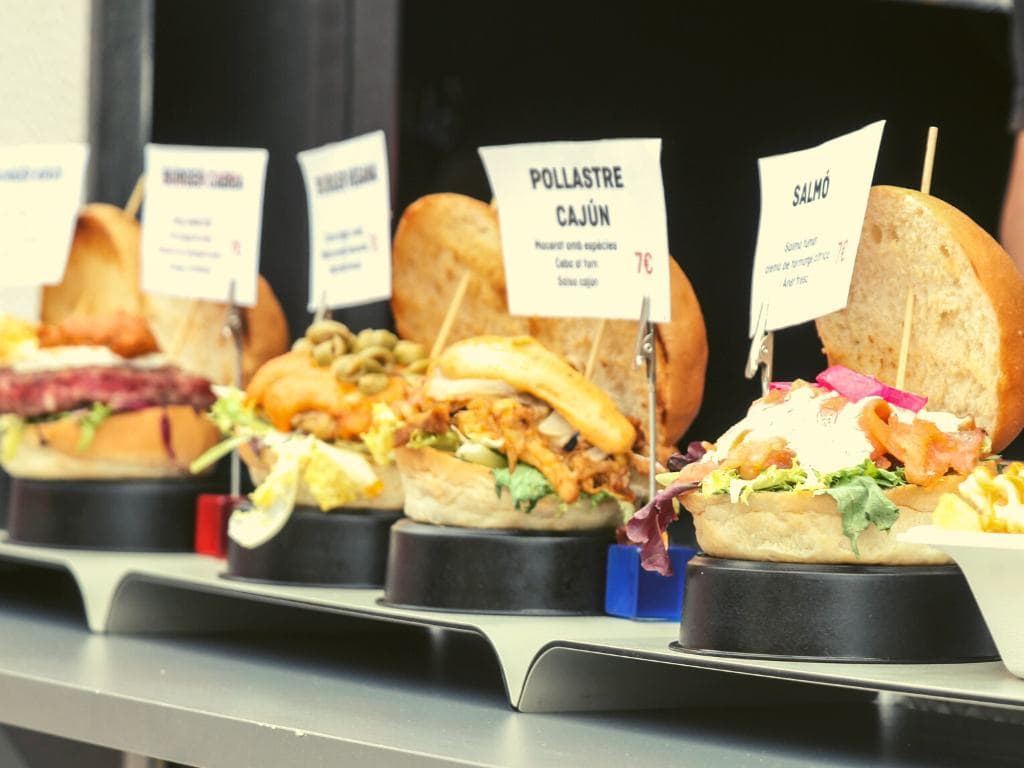
When it comes to ordering or making a sandwich in Spanish, you’ll need to know the most prevalent types of sandwich bread, fillings, condiments, and other words related to sandwiches in Spanish. Check them out ⤵
Types of Sandwich Bread in Spanish
Many types of bread can be used for sandwiches. Here are some of the most common:
🍞 Pan de molde – Sliced bread
🍞 Pan de sándwich – Sandwich bread
🍞 Pan de barra – Baguette
🍞 La ciabatta – Ciabatta
🍞 La focaccia – Focaccia
🍞 Pan integral – Whole wheat bread
🍞 Pan blanco – White bread
🍞 Baguette – Baguette
🍞 Panecillo – Roll (small bread roll)
Sandwich Fillings in Spanish
When it comes to sandwich fillings (rellenos), the possibilities are endless. Here are some familiar fillings you might encounter in a Spanish-speaking country:
🐖 Jamón – Ham
🧀 Queso – Cheese
🐔 Pollo – Chicken
🦃 Pavo – Turkey
🐟 Atún – Tuna
🥚 Huevo – Egg
🍅 Tomate -Tomato
🥬 Lechuga – Lettuce
🧅 Cebolla – Onion
🥑 Aguacate – Avocado
🥪 Aceitunas – Olives
🥒 Pepinillos – Pickles
🦀 Cangrejo – Crab
🥩 Roast beef – Roast beef
🐄 Carne de res – Beef
🥓 Tocino – Bacon
🍤 Camarones – Shrimp
🧀 Queso suizo – Swiss cheese
🍄 Champiñones – Mushrooms
🍆 Berenjena – Eggplant
🧀 Queso cheddar – Cheddar cheese
🌶️ Pimientos – Peppers
Condiments in Spanish
No sandwich is complete without the right condiments. Here are some of the best sandwich condiments:

🥪 Mayonesa – Mayonnaise
🥪 Mostaza – Mustard
🍅 Ketchup – Ketchup
🌶️ Salsa picante – Hot sauce
🍅 Salsa de tomate – Tomato sauce
🧄 Salsa de ajo – Garlic sauce
🍖 Salsa barbacoa – Barbecue sauce
🍯 Salsa de mostaza y miel – Honey mustard sauce
Common Sandwich Verbs in Spanish
When ordering a sandwich, it’s important to know the right verbs to use. Here are some natural sandwich-related verbs in Spanish:
🥪 Pedir – To order
🥪 Preparar – To prepare
🥪 Cortar – To cut
🥪 Untar – To spread
🥪 Rellenar – To fill
🥪 Servir – To serve
🥪 Comer – To eat
🥪 Degustar – To taste
🥪 Disfrutar – To enjoy
🥪 Compartir – To share
🥪 Probar – To try
🥪 Saborear – To savor
🥪 Satisfacer el apetito – To satisfy one’s appetite
🥪 Pedir para llevar – To order for takeout
🥪 Reservar una mesa – To reserve a table
🥪 Pagar la cuenta – To pay the bill
🥪 Recoger – To pick up (food)
🥪 Beber – To drink (beverage)
🥪 Solicitar – To request
🥪 Añadir – To add
🥪 Condimentar – To season
🥪 Empacar – To pack
🥪 Saber bien – To taste good
More Spanish Sandwich Vocabulary
Look at these sandwich Spanish-English translations you might find helpful:
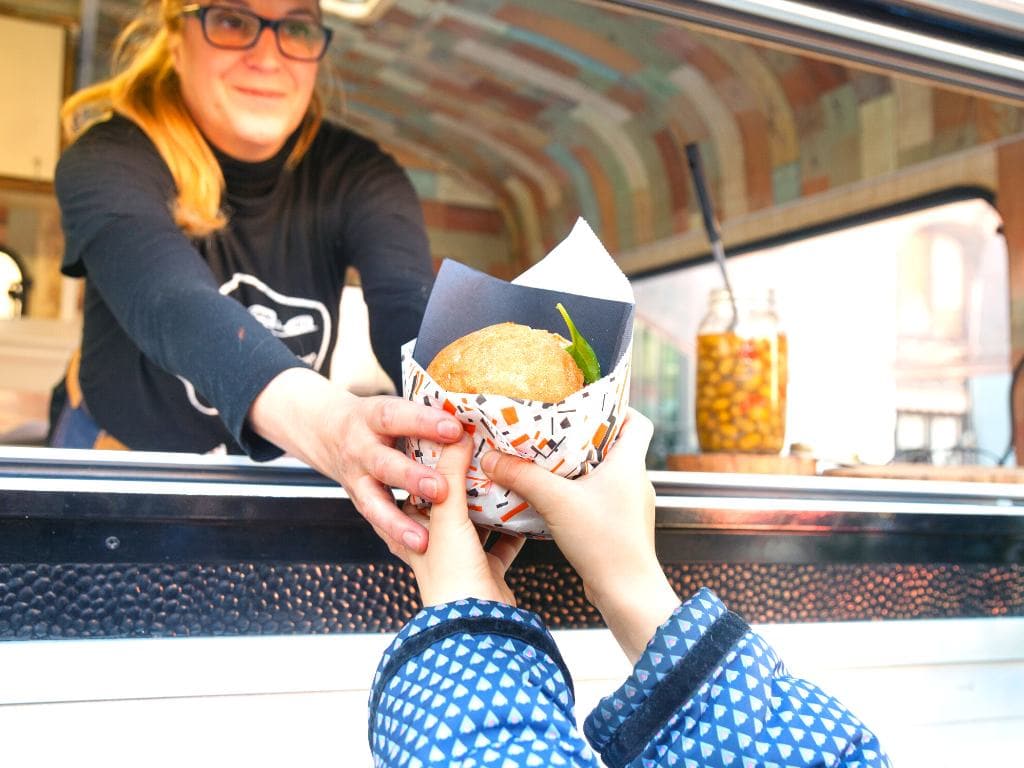
🥪 Sándwich club – Club sandwich
🥓 Sándwich de tocino, lechuga y tomate – BLT
🥪 Sándwich de pastrami – Reuben
🥩 Sándwich de queso y carne de res – Philly cheese steak
🧀 Sándwich de queso a la parrilla – Grilled cheese
🥜🍯 Sándwich de mantequilla de maní y jalea – Peanut butter and jelly
🍞 Tostado – Toasted
🏪 Sandwichería – Sandwich shop
🏪 Charcutería – Deli
🥕🌽 Vegetariano – Vegetarian
🌿 Vegano – Vegan
🚫🌾 Sin gluten – Gluten-free
🥡 Comida para llevar – Takeout food
🍽️ Menú del día – Daily special menu
🍔🔥 Parrilla – Grill
Phrases for Ordering Sandwiches in Spanish
When ordering a sandwich in Spanish, use these phrases:
❓ ¿Este sándwich es vegetariano? – Is this sandwich vegetarian?
❓ Un sándwich, por favor. – I’ll have a sandwich, please.
❓ ¿Puedo tener más mayonesa en mi sándwich? – Could I get extra mayo on my sandwich?
❓ ¿Sirven sándwiches sin gluten? – Do you serve gluten-free sandwiches?
❓ ¿Puedo llevar mi sándwich? – Can I get my sandwich to go?
❓ ¿Cuál es el sándwich del día? – What’s the sandwich of the day?
❓ ¿El sándwich es picante? – Is the sandwich spicy?
❓ ¿Cuántos sándwiches? – How many sandwiches?
Sandwich Spanish: FAQ’s
What is a Spanish sandwich called (in Spain)?
In Spain, sandwiches are most often referred to as bocadillos—crispy baguettes filled with classic Spanish ingredients like Serrano ham or tortilla de patata (potato omelet). The term sándwich can also be used to refer to a sandwich made with sandwich bread. There are also several other terms to refer to specific types of sandwiches in Spain like montaditos, pulguitas, and bikinis.
Does sandwich in Spanish have an accent?
Yes, sandwich in Spanish carries an accent over the letter a: sándwich.
Is sandwich in Spanish masculine or feminine?
The word “el sándwich” is masculine in Spanish. To make it plural, add -es: los sándwiches.
How do you say delicious sandwich?
To express “It’s a delicious sandwich,” in Spanish you say, “Es un sándwich delicioso.” Learn more words for delicious in Spanish.
How do you say I like the sandwich in Spanish?
In Spanish, I like the sandwich is “Me gusta el sandwich.” You can replace the word “sandwich” with a certain type of traditional sandwich from Spain or Latin America if you’d like to be more specific.
Sandwich in Spanish Translation: Final Thoughts

In conclusion, saying sandwich in the Spanish language isn’t as easy as it seems!
By learning the different terms for sandwiches, you’ve taken the first step to learning how to say sandwich in whatever Spanish-speaking country you visit. Now, you can order with the confidence that you’ll actually get what you asked for! ¡Buen provecho!
More Language Learning Blogs
- How to Say Omelet in Spanish (5 Different Types)
- Lingopie Review: Everything You Need to Know About the Language Learning Platform
- How to Say For in Spanish: Por, Para, or Something Else?
- How Many Spanish Words Are There in 2024? (Yes, it Changes!)
- 10 Tips for Learning Spanish Quickly from a Spanish Teacher
- What is Gluten Free in Spanish (+ Translation Cheatsheet)
- Free Printable 2024 Spanish Calendar (Color or B&W)
- 240 Spanish Art Words for a Colorful Trip to Spain
- Intercambio in Spain: English/Spanish Language Exchange
- What Does the Spanish “Buen Provecho” Mean in English?
- 19 Festive Ways to Say “Happy New Year” in Spanish
- How Do You Say Merry Christmas in Spanish (33 Ways!)
- Sandwich in Spanish: How to Say “Sandwich” in 21 Ways!
- Happy Halloween in Spanish: 139 Spooky Spanish Words
- 100+ Spanish Words That Start With W (& Words Containing W)
